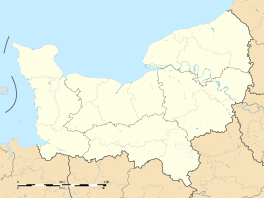Saint-Lambert, Calvados
| Saint-Lambert | |
|---|---|
 |
|
| Coordinates: 48°56′15″N 0°32′56″W / 48.9374°N 0.5489°WCoordinates: 48°56′15″N 0°32′56″W / 48.9374°N 0.5489°W | |
| Country | France |
| Region | Normandy |
| Department | Calvados |
| Arrondissement | Caen |
| Canton | Thury-Harcourt |
| Intercommunality | Suisse Normande |
| Government | |
| • Mayor (2008–2014) | Daniel Morel |
| Area1 | 7.45 km2 (2.88 sq mi) |
| Population (2008)2 | 239 |
| • Density | 32/km2 (83/sq mi) |
| Time zone | CET (UTC+1) |
| • Summer (DST) | CEST (UTC+2) |
| INSEE/Postal code | 14602 /14570 |
| Elevation | 29–264 m (95–866 ft) (avg. 266 m or 873 ft) |
|
1 French Land Register data, which excludes lakes, ponds, glaciers > 1 km² (0.386 sq mi or 247 acres) and river estuaries. 2Population without double counting: residents of multiple communes (e.g., students and military personnel) only counted once. |
|
1 French Land Register data, which excludes lakes, ponds, glaciers > 1 km² (0.386 sq mi or 247 acres) and river estuaries.
Saint-Lambert, is a commune in the Calvados department in the Normandy region in northwestern France.
The full name Saint-Lambert-sur-Dives recognises the Dives River that runs along the south edge of the village, location of the final battle of the Normandy campaign of 1944. While often referred to as the Battle of the Falaise Gap, Saint-Lambert was the last village in the narrowing gap between the Canadians and Polish forces advancing southwards from Falaise and Trun, and the American and Free French forces pushing northwards from Argentan and Chambois. The capture of Saint-Lambert would finally close the gap, and trap tens of thousands of German troops in the Falaise pocket.
On August 18, 1944 Major David Vivian Currie, commanding the Sherman tanks of C Squadron of the 29th Armoured Reconnaissance Regiment (The South Alberta Regiment), with attached infantry from "B" and "C" companies of the Argyll and Sutherland Highlanders of Canada and the Lincoln and Welland Regiment (all of the Canadian 4th Armoured Division), was ordered to move from Trun to capture and hold the village, and to attempt to link up with the American forces understood to be advancing towards the village from Chambois, less than two miles away. Events in and around St. Lambert over the next three days would eventually be recognized by the awarding of the Victoria Cross to Major Currie.
During the early hours of the action, four unarmed personnel from the Canadian Army Film and Photo Unit arrived in St. Lambert in two jeeps. They were able to record the events as they unfolded in black and white photographs (taken by photographer Lt. Donald I. Grant) and on cine film (taken by cameraman Sgt. Jack Stollery). The cine film captures the moment when Major Currie sees a German convoy coming towards the Canadian position, pulls his pistol and steps out to take the officer commanding the convoy by surprise, forcing him to surrender his troops. Lt. Grant's still photo captures the German officer in the seconds after his surrender, his arms still in the air, and also captures Sgt. Stollery at the far left of the photo, his cine camera clearly visible in his hands as he films the events as they unfolded. The series of black and white still photographs taken on August 19 by Lt. Grant are readily available through the Library and Archives of Canada. Unfortunately the original cine film was destroyed in a fire during the 1960s while under the care of the National Film Board of Canada. Fortunately, pieces of the original footage were picked up by newsreel companies and can be seen in several newsreels released shortly after the battle.
...
Wikipedia


